We may have been glad to see the back of January, but it certainly wasn’t all blue. The first month of the year brought excitement to the wine world with Domaine de la Romanée-Conti’s (DRC) 2015 release, and to Wine Lister with our first ever 1000-point Brand score. For much of London’s bustling City, the end of February means one thing: bonus time. The Financial Times’ February edition of How To Spend It already features the iconic DRC – below are some further ideas for wines to blow the budget.
Prices from our data partner, Wine Owners, are shown ex duty and sales tax (VAT) per bottle as averages across Wine Lister featured vintages.
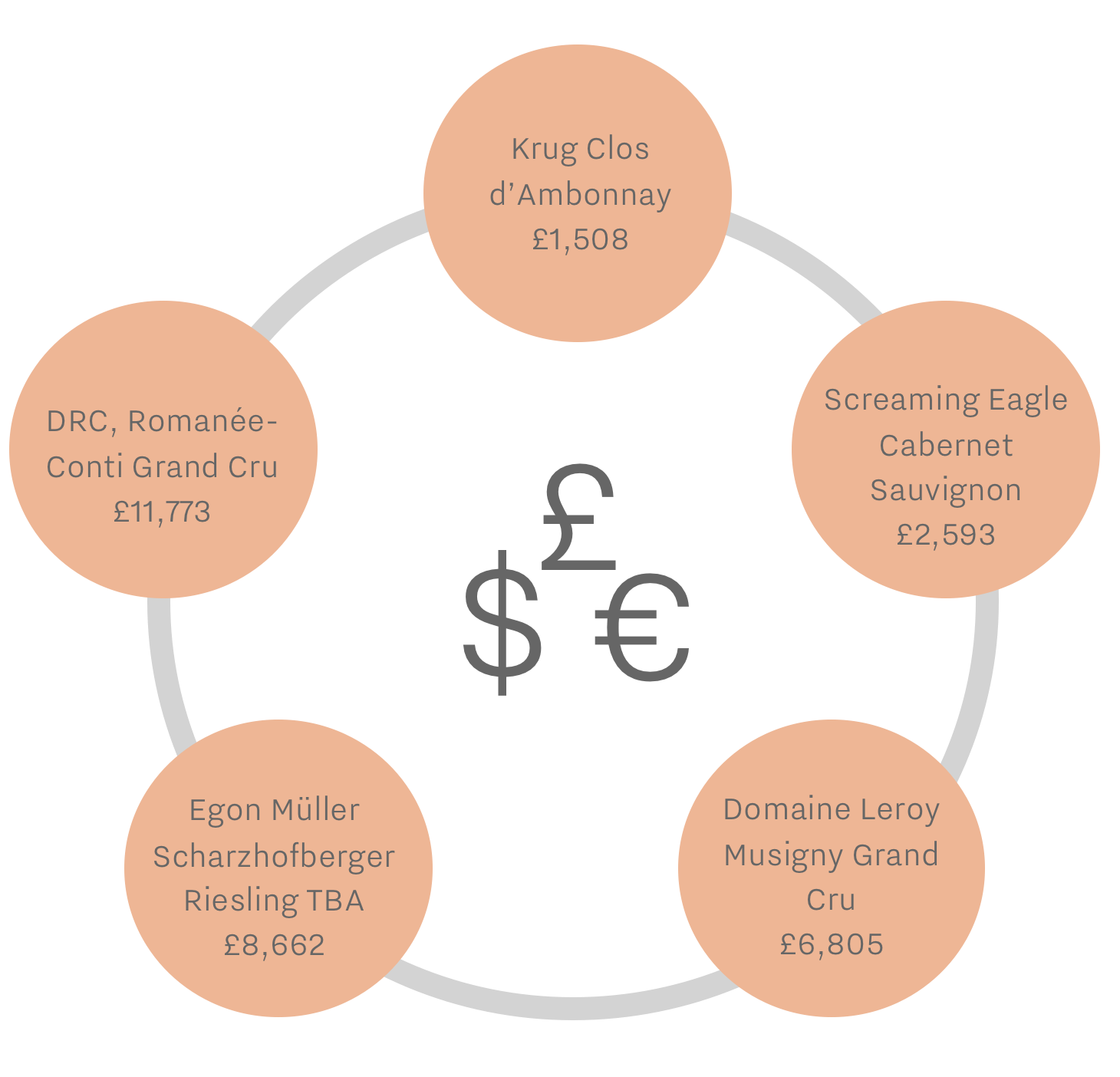
- Krug Clos d’Ambonnay
While Dom Pérignon or Louis Roederer’s Cristal are more commonly associated with City celebrations, those in the know will be toasting with Krug’s famous Pinot Noir expression. With an average Quality score of 969 and a price of £1,367 per bottle for the latest available vintage (2000), a glass of Krug Clos d’Ambonnay is, in itself, cause for celebration.
- Screaming Eagle Cabernet Sauvignon
If you’re one of the lucky few on Screaming Eagle’s direct mailing list, congratulations. It is one of the most talked-about wines by the trade based on the results of Wine Lister’s proprietary Founding Member survey, and counts over 17,000 monthly online searches on Wine-Searcher. The average £2,593 price tag per bottle is therefore a small price to pay, if indeed you are able to get your hands on one of the 7,800 bottles produced each year.
- Egon Müller Scharzhofberger Riesling TBA
Even harder to find is Egon Müller’s Scharzhofberger Riesling TBA. It breaks a number of records, including Wine Lister’s rarest wine (with an average of only 150 bottles produced per annum) and the highest ever average Wine Lister Quality score (995). Prices range from £5,848 per bottle to over £21,000 per bottle for older vintages.
- Domaine Leroy Musigny Grand Cru
The second most expensive of all French wines, let alone in Burgundy, is Domaine Leroy’s Musigny. At just over half the price of DRC Romanée-Conti, averaging £6,805 per bottle, its consistent quality is matched by impressive price growth, with a compound average growth rate of 26%. It featured in last year’s Listed blog, “the best wines money can buy”, which certainly still rings true.
After a distinctly Burgundian start to 2018, we are ringing the changes this week to look at some of our most improved Brand scores, with Champagne dominating.
Alongside presence in the world’s best restaurants, Wine Lister’s Brand score measures a wine’s online popularity – as indicated by the number of searches received on Wine Searcher – as a marker of real consumer demand.
The search frequency data for December is in, and it is no surprise that searches in Champagne increased significantly leading up to the Christmas period.
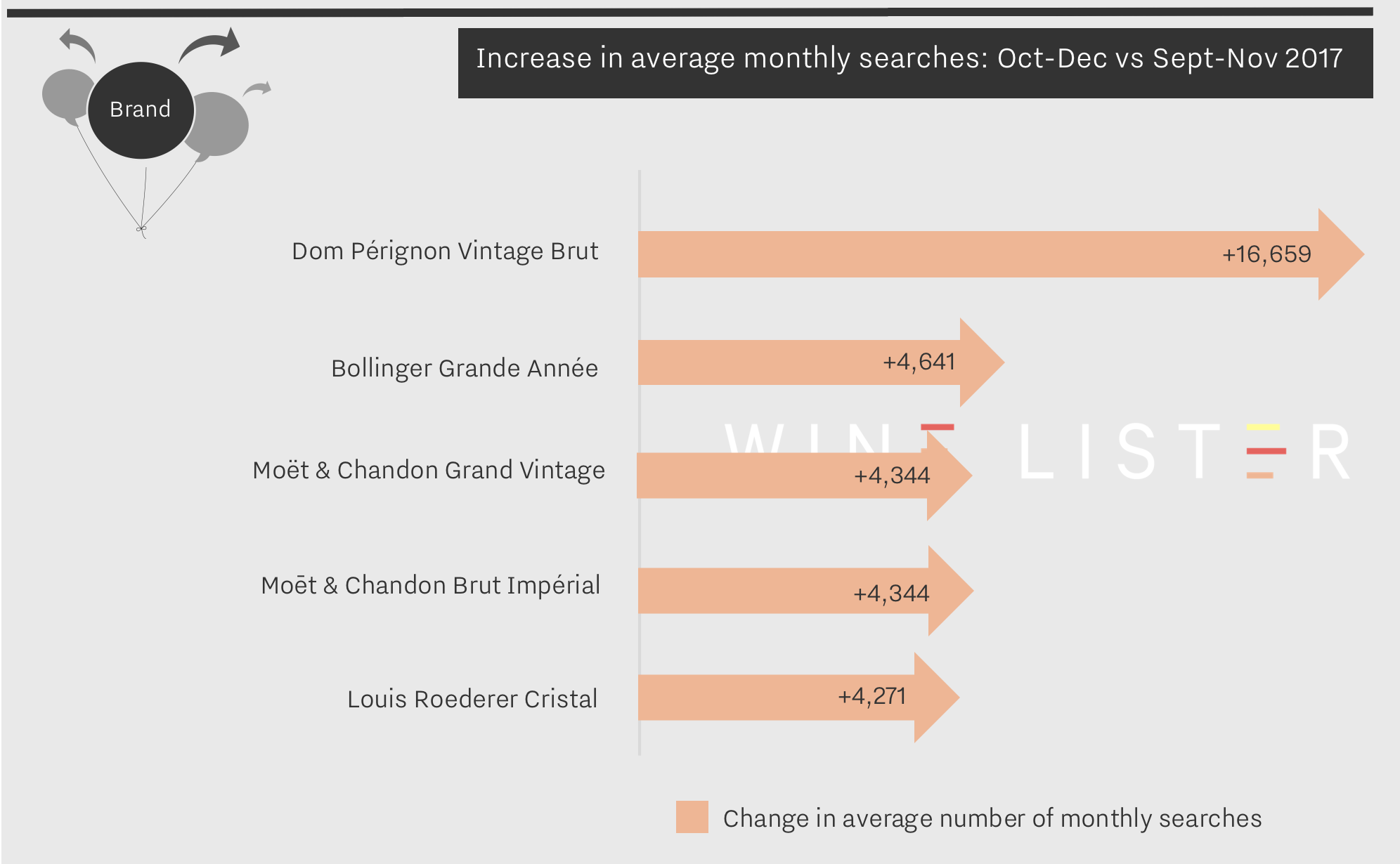
During arguably the busiest period of the year for searching and purchasing wines, these five wines gained between 20% and 77% increase in search frequency. The appearance of Dom Pérignon Vintage Brut at the top of search frequency lists is a shock to no one considering its position as one of the most searched-for wines of all time. Indeed, it consistently held the number one search spot from July to September last year. The Christmas influence still managed to add 16,659 online searches, allowing this almighty brand to achieve Wine Lister’s first ever perfect Brand score (1000)!
Next on the list is Bollinger Grande Année. Its impressive 77% increase in search frequency at the end of last year can also be attributed to the festive season, but may also have been boosted by the release of the 2007 vintage earlier in the year. Bollinger’s new Brand score is up 16 points on the previous quarter at 975.
Our next two appearances hail from the same owner as the first, Champagne divinity LVMH. Moët & Chandon, often considered the definitive Champagne brand holds not one, but two spots in the top five most searched for wines of the last three months. Moët & Chandon Grand Vintage is perhaps a classic Christmas choice, but the appearance of a non-vintage cuvee, the Moët & Chandon Brut Impérial is testament to the power of the Moët & Chandon brand. Each earned an increase in search frequency of 33%, bringing Brand scores to 987 and 938 respectively.
Last but not least, Louis Roederer Cristal takes fifth place with a search frequency increase of 20%. While achieving a fractional increase in searches (4,271) compared with Dom Pérignon, its presence in 54% of restaurants and consistent high quality (Quality score 970) makes Cristal an all-round achiever, and therefore a choice that’s not just for Christmas.
Champagne’s Brand prowess is clear, but these five are the shining stars of their region. It is interesting to note that the sixth most searched-for wine on our most recent list is in fact not a Champagne at all, but Château Margaux (Brand score 998).
With the latest online search frequency data in from Wine-Searcher, we can see which wines rose in popularity during November. Each month we look at the last three months’ worth of search data, measured against the previous period, to see which wines have grown most in popularity. With five of the world’s six most popular wines making the greatest gains during November, it appears that demand for the biggest brands shows no sign of diminishing, and that the public is quick to pick up on announcements regarding the most famous fine wine producers.
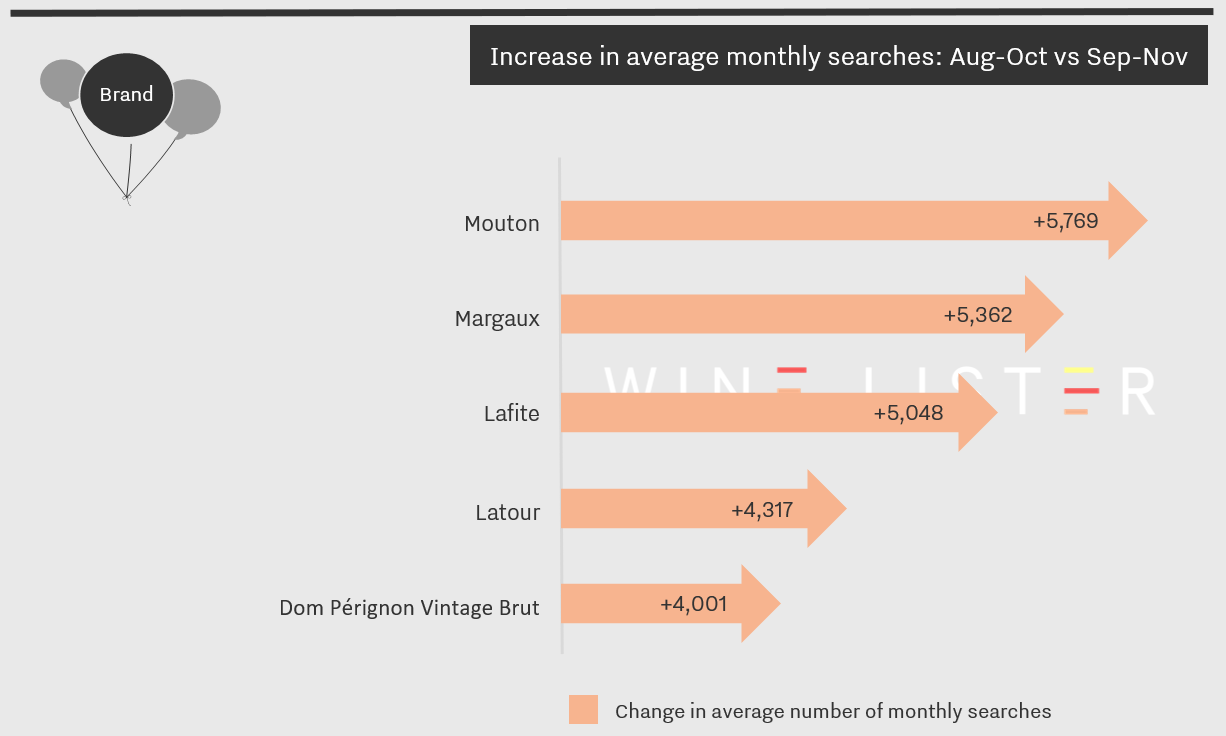
Mouton, the world’s second-most popular wine, made the greatest gains during November. This is likely thanks to the release of the label for the 2015 vintage. It features a witty juxtaposition of Gerhard Richter’s “Flux” with the reiteration of part of Mouton’s motto, “Mouton ne change” (Mouton never changes), in the context of a generational shift as Philippine de Rothschild’s three children take the helm after her death in 2014.
Snapping at Mouton’s heels was Margaux. It too announced during November that it will release its 2015 vintage in a commemorative bottle – the first time the château has done so – paying homage to Paul Pontallier who was winemaker at the property for almost 30 years. With Margaux 2015 achieving one the best Quality scores of the vintage, it seems a fitting tribute.
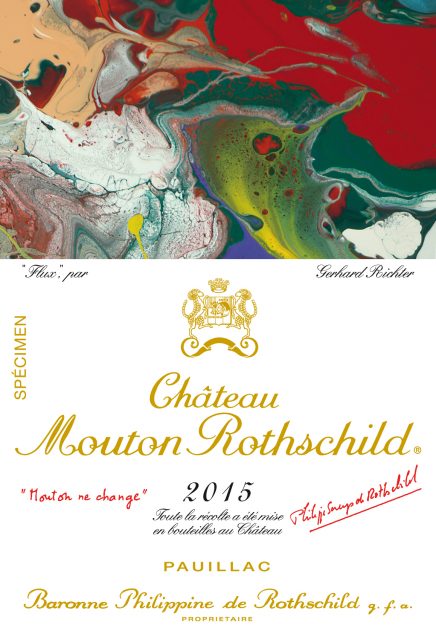
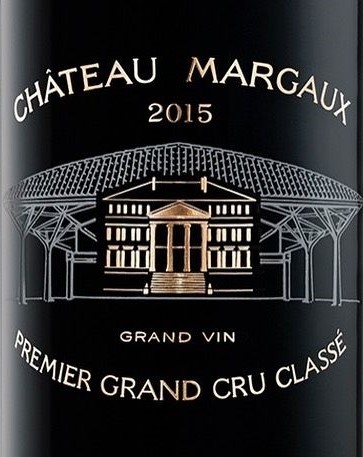
Lafite came next. In mid-November it was announced that in March 2018 Saskia de Rothschild will be taking over as chairwoman of the château and Jean-Guillaume Prats of Moët Hennessy will become President and CEO. With Lafite currently the most popular wine in the world, and one of just five wines on Wine Lister to achieve a Brand score of 999 – alongside Dom Pérignon Vintage Brut, Mouton, Latour, and Yquem (no wine scores 1,000) – the duo have a formidable reputation to maintain.
Latour was the fourth-biggest gainer, its search frequency increasing 8% (4,317 searches). Whilst the increased interest in the other Médoc first growths can be attributed to a significant announcement, the reason behind Latour’s surge in popularity is less obvious. Related news is of course the acquisition by Artemis Domaines – Latour owner François Pinault’s holding company – of Burgundian Grand Cru monopole Clos de Tart.
Breaking the Bordeaux first growths’ dominance on this month’s popularity stakes was Dom Pérignon, a brand whose online popularity has soared over the second half of the year. Early in November Moët Hennessy announced the launch of Clos19, an online shop selling its prestigious brands – one of which is Dom Pérignon. Cannily introduced before the festive season, during which Champagne’s popularity surges – it seems that the region’s strongest brand has further benefited from the new platform.
The annual spate of releases in September has influenced this month’s gainers in online search frequency. For the third consecutive month, Dom Pérignon Vintage Brut has seen the largest increase in average monthly searches, which we calculate using three-month data from Wine-Searcher measured against the previous period. Dom Pérignon 2009 was released in early September, and the wine’s increase of 5,154 searches is the largest incremental monthly increase seen this year, taking it to 60,241 average searches per month: the highest of any Champagne and fifth highest of all wines.
Following last month’s narrowing of regions within the top five (only two were featured), the breadth in September significantly increased, with icons from California, Bordeaux, Piedmont, and Chile joining Champagne. The number of searches has also increased dramatically after the summer slowdown, with 19 wines seeing an increase of over 1,000 average monthly searches. The release of Opus One 2014 at the beginning of September – judged “a gorgeous wine” by our partner critic Antonio Galloni – has boosted interest in this Napa Valley stalwart, with an increase of 4,651 searches taking it to over 40,000 searches per month.
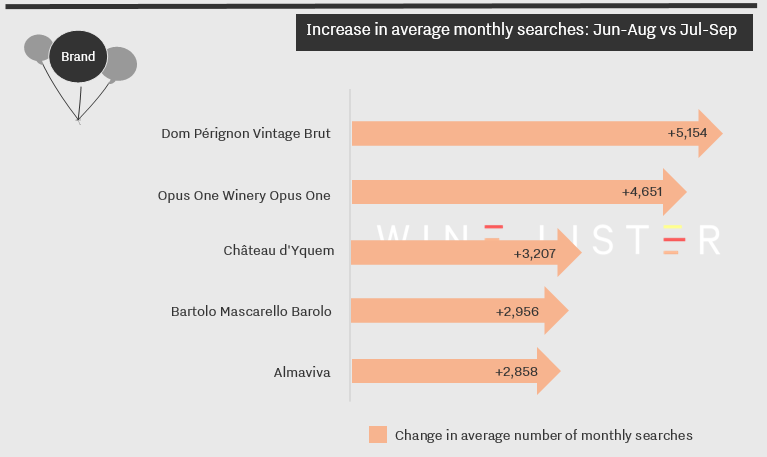
Château d’Yquem is another wine to see online search frequency rise on the back of a September release. The 2015 was released alongside Opus One 2014 at €250 ex-négociant.
The next in the table, Bartolo Mascarello Barolo, has the lowest search frequency of any of the wines above, with an average 10,075 per month. Nevertheless, with an overall Wine Lister score of 941/1,000 the wine is one of the great names of Barolo: the fourth best overall on Wine Lister.
Almaviva celebrated its twentieth anniversary in June, while its producer Viña Concha y Toro has recently entered the global ranking inside the Top 10 Beverages category within the Dow Jones Sustainability Index for the first time. With the release of Almaviva 2015 in early September adding to the interest, the wine has seen an increase of 2,858 online monthly searches, taking it to 11,291.
Champagne continues to find itself a popular tipple amongst summer drinkers, the latest Wine Searcher data shows. Each month we look at the last three months’ worth of search data, measured against the previous period, to see which wines have grown most in popularity. Last month’s data featured two Champagnes in the top five, and this month’s – looking at data from June to August – features three.
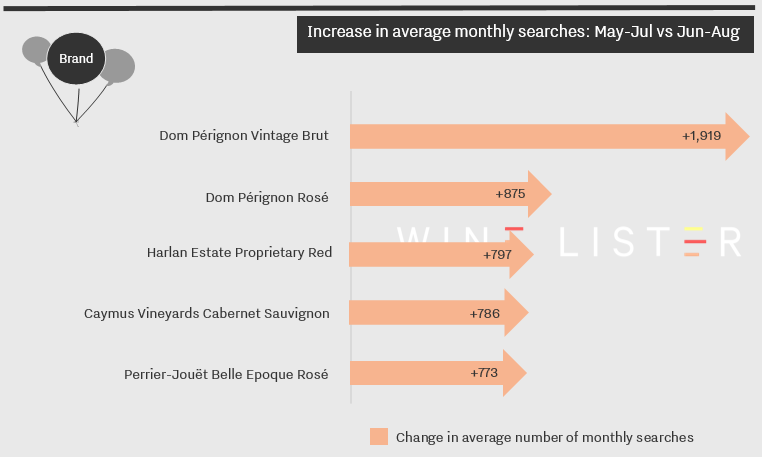
For the second month in a row, Dom Pérignon Vintage Brut finds itself in first place, with an increase of 1,919 searches taking the wine to an impressive 57,000 searches on average per month. This also makes it the fifth most searched-for wine on Wine Searcher from June to August, beaten only by Bordeaux heavyweights Lafite, Mouton, Margaux, and Petrus.
The producer’s Rosé takes the second spot, although with 9,300 searches on average per month it falls some way behind the dizzy popularity of its sibling. Proving the unquenchable appeal of drinking pink Champagne in the sun, Perrier-Jouët Belle Epoque Rosé makes up this month’s trio. Starting from the lowest number of average searches of the five wines, at around 1,600 per month, it jumps to 2,300 searches with the latest data update.
The breadth of regions has narrowed this month, with the remaining two wines both Cabernet-based and hailing from Napa: Harlan Estate Proprietary Red and Caymus Vineyards Cabernet Sauvignon. The former is one of the region’s biggest names, a self-proclaimed “First Growth” of California, costing on average £665 per bottle. Caymus Vineyards, meanwhile, averages £100 a bottle but is a favourite amongst consumers, and with an overall score of 747/1,000 shows that high quality doesn’t always come with a high price to match.
Champagne and Californian Cabernets: the drinks of the summer. You heard it here first.
As Wine Lister’s holistic rating system demonstrates, there are many factors (nine criteria, in all) to take into account when calculating a wine’s greatness. One of these is distribution in the world’s top restaurants, our measure of a wine’s prestige and clout on the international market. In order to identify the restaurants that count – not just for the food but for the wine – we have created a matrix of global restaurants with Michelin stars, 50 Best Restaurants, World of Fine Wine Best Wine List awards, and more. We take the most formidable combination of these as the basis for our painstaking analysis.
We are expanding our coverage constantly, and the latest instalment is now in. This year alone has seen an increase of 50%, to 150 restaurants analysed. New entrants come from across the globe, from New York’s Balthazar to Paris’s Carré des Feuillants.
The table below shows the 20 wines to have seen their restaurant presence increase the most since the last update in April:
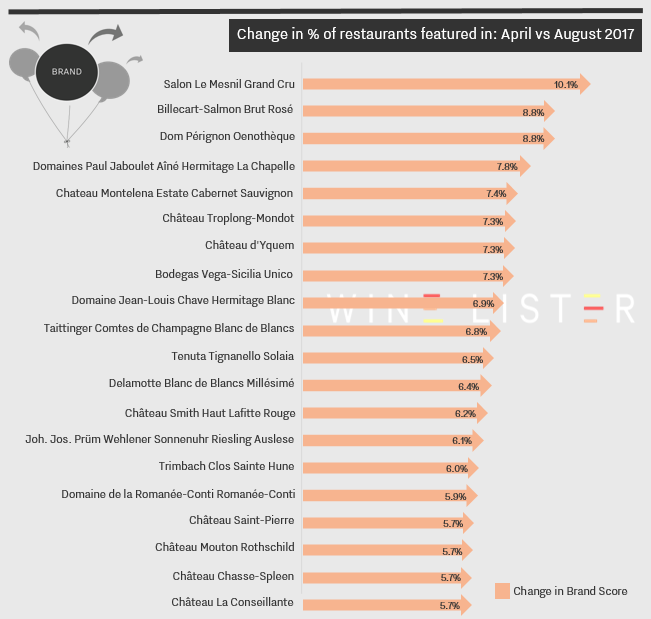
The top three wines are Champagnes: Salon Le Mesnil, Billecart-Salmon Brut Rosé, and Dom Pérignon Oenothèque (the last all the more impressive since the wine was re-branded a few years ago). None of them, however, is the wine with the largest restaurant presence. That accolade falls to Yquem, which saw its presence increase by 7.3% in the latest update, appearing on 69% of the world’s top wine lists – including Boulud in New York and Sketch in London.
Second most popular of the wines above is Mouton Rothschild, whose restaurant presence increased by 5.7%, and which overall features on 58% of the best restaurants, from The French Laundry in California to L’Atelier de Joël Robuchon in Hong Kong.
It is also interesting to note the wines that have relatively low overall restaurant presence but saw a significant increase in the latest update, suggesting that their stars are on the rise. These include Bordeaux Saint Pierre and Champagne Delamotte Blanc de Blancs Millésimé, which appeared on 2% of the previous restaurant lists but are now at 8% and 9% respectively. Meanwhile, Smith Haut Lafitte Rouge found its restaurant presence tip from 9% to 15% in the latest update.
The latest search frequency data is in from Wine-Searcher, and with it we can see which wines enjoyed the greatest popularity gains during July. After the en primeur campaign fuelled the big surges of May and June, July’s top five gainers witnessed more modest gains. There is also more variety this month, with two Champagnes and a Napa joining two Bordeaux right bank heavyweights.
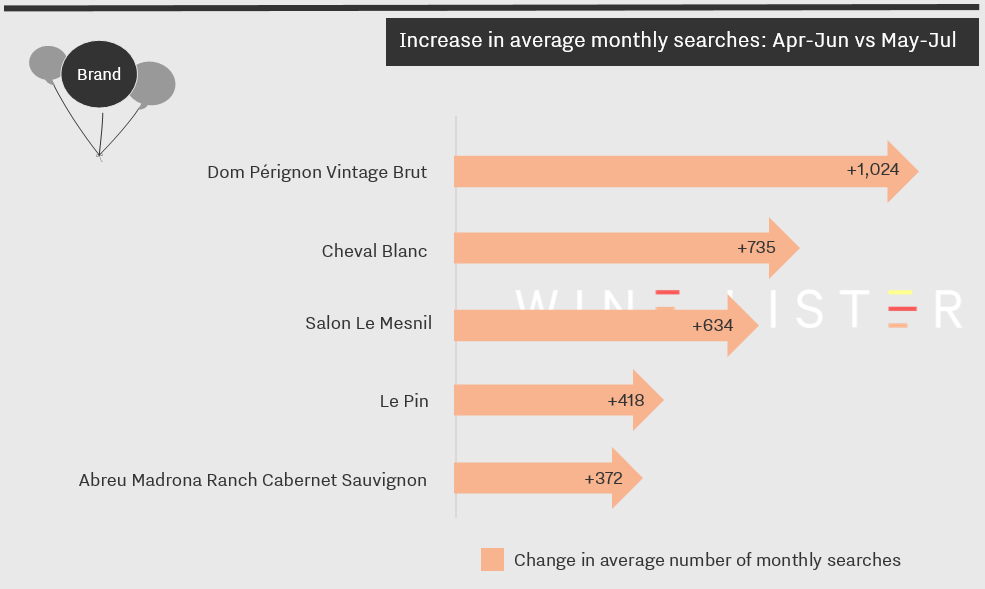
Experiencing the greatest increase in popularity during July was Dom Pérignon Vintage Brut – particularly impressive considering it started from an already extraordinarily strong average of over 54,000 searches each month.
Next came Cheval Blanc, whose 2016 vintage was released in early June, before July saw the release of Salon Le Mesnil 2006. Described by Wine Lister partner critic Antonio Galloni as an “utterly compelling Champagne to follow over the next several decades”, its rise in online popularity suggests that consumers have already started to track its progress.
The last two wines are both produced on very small scales. Le Pin, notoriously rare, released its 2016 vintage in late June, which likely contributed to its increase in online popularity, at least among those lucky few with both an allocation and requisite funds. About 6,000 bottles of Napa Valley’s Abreu Madrona Ranch Cabernet Sauvignon are produced each year. As we saw in our recent post on California’s most expensive wines, production levels play a big role in the region’s prices. Perhaps the rarity of Abreu Madrona, the region’s eighth most expensive wine, is helping to boost its caché.
What makes the perfect wine?
Using the entirety of a 1,000-point scale, Wine Lister’s scores are calculated using nine criteria that define iconic wines. These fall into the categories of Quality, Brand and Economics, giving a 360° view of the finest wines in the world.
Unlike wine critics’ scores, which sporadically feature a perfect 100/100, a perfect Wine Lister score of 1,000/1,000 is practically, though not theoretically, impossible. The perfect wine would have to be the best in the world across every single criterion – a magical combination of ingredients.
The perfect wine does not belong to any one region. In terms of quality, it has the perfect critic score of Sauterne’s unsurpassed Château d’Yquem (1), and the ageing potential of Cockburn’s Vintage Port (2). Its brand is legendary: like Dom Pérignon, it is found throughout the world’s top restaurants (3), and its online monthly searches rival those of Lafite (4).
The perfect wine outperforms on price. Already with a price per bottle to match that of Romanée-Conti (5), its vintages see price increases in both the short- (6) and long-term (7), without undue fluctuation (8). Finally, like Mouton, the perfect wine is traded in large volumes (9).
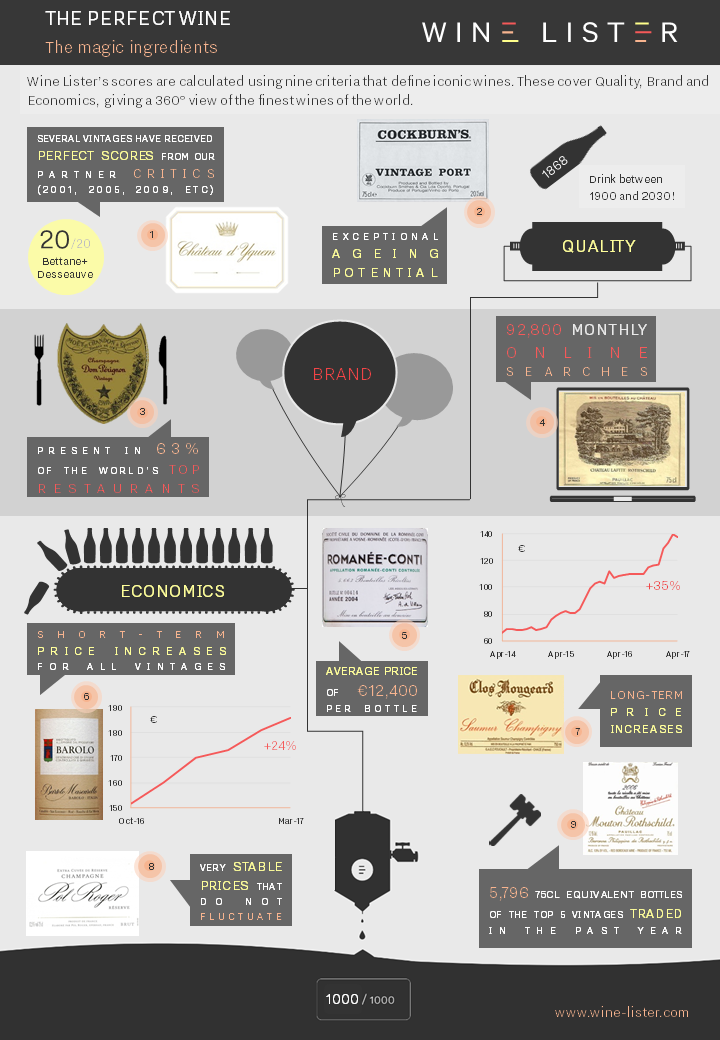
Download a PDF version here.
First published in French in En Magnum.









